************ HISTORY OF CHRISTMAS CACTI ************
(continuation and end : page 2 / 2)
THE FIRST HYBRIDS, THEN THE MOST RECENT.
The hybrids creation began a few years after the discovery of
S. truncata, when it started to be grown and exported to Europe. From the second
half of the 19th century, many cultivars were already available, often created
in England.
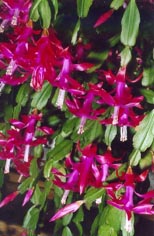 One
of the best known is S.X "buckleyi", obtained by
Buckley and described in 1852. It is an interspecific hybrid between S. truncata
and S. russelliana. Its stem-segments are rounded, their shape reminds of the
stem-segments of S. russelliana but those of
One
of the best known is S.X "buckleyi", obtained by
Buckley and described in 1852. It is an interspecific hybrid between S. truncata
and S. russelliana. Its stem-segments are rounded, their shape reminds of the
stem-segments of S. russelliana but those of
S.X "buckleyi" are bigger. Resemblance to S.russelliana has frequently
provoked a confusion between the two plants.
S.X "buckleyi" blooms from December to January, and
even February, it is one of the last blooming hybrids.
In my collection I have a plant which looks like S. X "buckleyi"
and which I inherited from a relative. It was already grown in the 1950s by
this relative. I think it's S. X "buckleyi", without my being absolutely
sure of its identification. As it's an old plant, it has a
bulky size, and the stem bottoms became lignified. It's the Christmas cactus
which was common during my childhood. I think this is the one commonly called
"the genuine" Christmas cactus by some people. It's now quite impossible
to find it in garden centers.
Since then, lots of cultivars have appeared, created in the United
Kingdom, in Germany, in Denmark, in the Netherlands, and since the 1960s in
the United States and in Australia. I particularly think of the hybrids created
by Joyce Carr, among which we can find intergeneric hybrids between Schlumbergera
and Disocactus. Joyce Carr's hybrids are very difficult to find.
Among my favourite hybrids, I will quote S.X "White Christmas" marketed
in the United States in 1973 and S.X "Bridgeport", marketed in 1988,
still in the United States ; this plant is also a white blooming Schlumbergera
whose white rounded flower petals’ shape is absolutely unique.
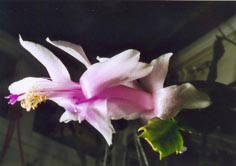 ****************
**************** 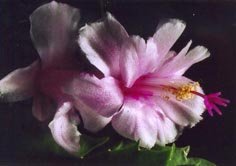
S. X "White Christmas" ............................................................S.
X. "Bridgeport"
The pale pink shade of these flowers, normally white in all catalogs,
is due to the fact that I didn't keep the temperature constantly over 15°C
to grow the plant from the flower buds formation to complete blooming. This
is an essential condition to obtain pure white flowers.
BIRTH OF SCHL. X "GOLD CHARM",
THE FIRST YELLOW BLOOMING SCHLUMBERGERA.
A huge step in new hybrids creation was achieved when creating
S.X ‘Gold Charm’, the first pure yellow blooming Schlumbergera.
(That is, when it is grown in a temperature constantly over 15°C ; otherwise,
the pure yellow color is mixed with pinkish zones ; besides, as the below photograph
shows it, this is a very beautiful mixture).
Between the moment when the hybridizer and producer Cobia
(from the United States) had the idea to carry out this creation and
the year when the plant was marketed on the US market, 15 years of patient
and thorough research had gone by.
The success appeared all the more delicate
since, before "Gold Charm", the yellow color didn't exist for
any Schlumbergera.
The closest to this yellow shade, were Schlumbergera with orange-coloured
blooms.
So, the main idea was to favour the yellow colour genetic material
(contained in the orange colour) to the detriment of the red colour genetic
material (also present in orange colour). In practice, pollinations were made
with orange-coloured blooming Schlumbergera, and 50.000 resulting
seeds were harvested, sown, and the plants were grown until they bloomed. Among
all these plants, one appeared which had a pure yellow bloom.
But, unfortunately, this plant was weak and the vegetative aspect was commercially
unacceptable.
It was therefore decided to cross this plant with white blooming
and with vigorous growth Schlumbergera. This crossing produced one fruit containing
200 seeds which were sown, and the plants were once more grown until they bloomed
for assessment. Among 150 plants which had yellow flowers, only one
was selected !
Schlumbergera X "Gold Charm" was born.

It was the first of many yellow blooming Schlumbergera.
HYBRIDS OF SCHLUMBERGERA ORSSICHIANA.
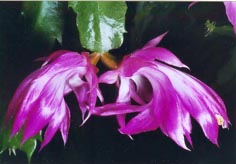 .......................................
....................................... 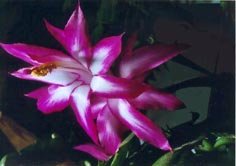
Schlumbergera orssichiana..............................................................Schlumbergera
X "Bristol Queen"
Schlumbergera orssichiana was discovered in the Brazilian forests
in 1978, i.e. more than 150 years after S. truncata and approximately 140 years
after S. russelliana. Its discovery led the Christmas cacti hybridization into
a new direction.
Beatrix Orssich was the first one who, in Brazil,
started to cross S. orssichiana with S. truncata. Thus, she obtained new hybrids
with much larger flowers than those of all known before Schlumbergera. Moreover,
the bloom shape was different, with a shorter tube and petals with sometimes
a dishevelled aspect. They are "Queens" she said. That’s how
the word "Queen" appeared in the first hybrid published by McMillan
in literature: Schlumbergera X "Bristol Queen" (photo above). This
hybrid was followed by many others, often including the word ‘Queen’
in their name.
Several of these hybrids, still difficult to find in garden centers
or even from cacti producers, are in my collection. They are easy to grow, they
prefer a little more shaded location than other Schlumbergera. They abundantly
bloom at the beginning of September. In my opinion, their name "Queen"
is really well deserved.
Many thanks to Beatrix Orssich and to A.J.S. McMillan who created
and developed the first ones.
THE PHOTOGRAPHS OF ALL MY SCHLUMBERGERA.
You will find the photographs of all my Schlumbergera in the September
to February galleries. They do not appear under the name of Schlumbergera but
under that of Zygocactus (shortened as Z.) which is sometimes
used as a synonym for Schlumbergera. (See note below).
September gallery : 8 Schlumbergera
photos.
October gallery : 11 Schlumbergera
photos.
November gallery : 16 Schlumbergera
photos.
December gallery : 13 Schlumbergera
photos.
January gallery : 7 Schlumbergera
photos.
February gallery : 1 Schlumbergera
photograph
2004 new Schlumbergera.
2005 new
Schlumbergera.
2006 new
Schlumbergera.
2007 new
Schlumbergera.
2008 new
Schlumbergera.
2009 new
Schlumbergera.
2010 new
Schlumbergera.
New :
Instead of surfing chronologically
in all the previous galleries,
you can directly go to
RECAPITULATIVE
GALLERY OF ALL MY SCHLUMBERGERA PHOTOS FROM 2002 TO 2010.
N.B. In my names of photos, I use both names: "Schlumbergera"
and "Zygocactus". Although the first is more accurate, botanical
or hybrid Schlumbergera are often known under the name of Zygocactus, in reference
to the zygomorphic shape of their blooms.
___________________________________
These two pages were written thanks to the invaluable documentation
provided by two books about Christmas cacti, books which are unavoidable
:
"Christmas Cacti, the genus Schlumbergera and
its hybrids" by A.J.S. McMillan and J.F. Horobin; published by David Hunt
and Nigel Taylor of Royal Botanic Gardens of Kew. (1995). This book is on sale
at the bookshop of KUENTZ Establishment : http://www.kuentz.com
"Zygocactus (Schlumbergera)" A Comprehensive
and Practical Guide For the Weekend Gardener’ by Mark E. Cobia.
All the photographs result from plants of my collection,
plants which I've been photographying for several years.
My article contains only a very small part of the fascinating
information given by these two books. I strongly advise all Christmas cacti
lovers to read them.
. BACK
TO HISTORY OF CHRISTMAS CACTI : page (1/2)
HISTORY
OF SCHLUMBERGERA ORSSICHIANA AND DEVELOPPEMENT OF ITS HYBRIDS (QUEEN)
THE PHOTO
GALLERY OF MY “QUEEN” HYBRIDS
HOME PAGE
**************************************************************
 One
of the best known is S.X "buckleyi", obtained by
Buckley and described in 1852. It is an interspecific hybrid between S. truncata
and S. russelliana. Its stem-segments are rounded, their shape reminds of the
stem-segments of S. russelliana but those of
One
of the best known is S.X "buckleyi", obtained by
Buckley and described in 1852. It is an interspecific hybrid between S. truncata
and S. russelliana. Its stem-segments are rounded, their shape reminds of the
stem-segments of S. russelliana but those of ****************
**************** 

 .......................................
....................................... 